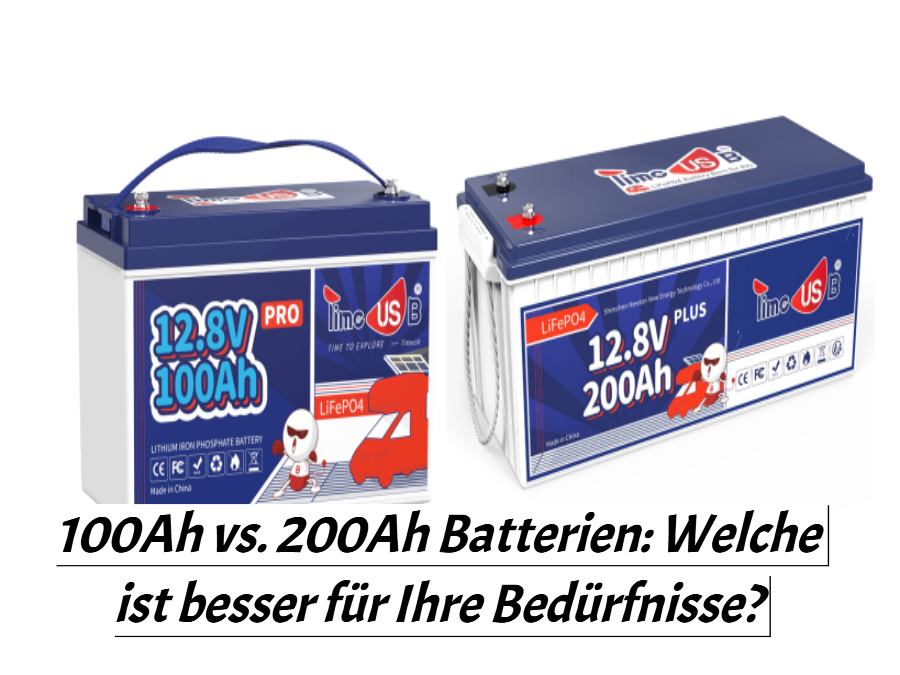[Full Guide] What is a DC-DC charger?
![[Vollständige Anleitung] Was ist ein DC-DC Ladegerät?](http://timeusbpower.de/cdn/shop/articles/Was_ist_ein_DC-DC_Ladegerat.jpg?v=1722159000&width=1600)
When it comes to powering electronic devices, a reliable and efficient energy source is essential. DC-DC chargers, also called DC-DC converters, are essential for converting one voltage level to another in direct current (DC) systems. This article explores how these chargers work and are used, highlighting their benefits and the ways in which they improve power conversion in a variety of devices and systems.
What is a DC-DC charger?
A DC-DC battery charger is a device that uses the charging current from a vehicle's alternator to charge a separate deep cycle battery while driving. This allows users to conveniently charge their RV or van battery on the go. The charger boosts the charging current from the alternator and passes it on to the auxiliary battery, effectively using the energy generated by the vehicle's engine. This feature provides a convenient and efficient solution to maintain battery charge while driving.
DC (direct current) is a type of electric current that flows in a single, constant direction, as opposed to AC (alternating current), in which the flow of electrons periodically reverses direction. DC is commonly used in batteries, solar panels, and electronic devices that require a steady flow of current in one direction.
A DC-DC charger, also known as a DC-DC converter or voltage converter, is an electronic device used to convert one voltage level to another within a direct current system. It finds application in various fields such as automobile, solar power systems, telecommunications and industrial equipment.
The DC-DC charger takes an input voltage from a DC source, such as a battery or power supply, and efficiently converts it into a different output voltage required by a specific device or system. It delivers regulated and stable DC voltage, ensuring compatibility and protecting sensitive components from voltage fluctuations.

The main function of a DC-DC charger is to convert a lower voltage current into a higher voltage current to charge a secondary battery. It follows a multi-stage process - constant, absorption and trickle charging - to charge the battery efficiently.
Why do you need a DC-DC charger?
First, we should know the differences between the starter battery and the chassis battery of a motorhome.
The differences between motorhome starter batteries and house batteries
The main difference between an RV starter battery and a home battery, also called a service battery or deep cycle battery, lies in their specific functions and design features.
starter batteries:
Starter batteries are designed to deliver short, high bursts of current to start the RV engine. They are usually measured in cranking amps (CA) or cold cranking amps (CCA) and are designed to deliver a large amount of current for a short period of time. These batteries have a high CCA rating to meet the needs of engine starting, but are not designed for deep discharges that require frequent discharging and recharging.
Household batteries (deep cycle batteries):
Household batteries, also known as deep cycle batteries, are designed to provide a consistent and reliable power supply over a longer period of time.These batteries are designed to be regularly discharged and recharged without negatively affecting their overall lifespan. They are optimized for deep discharge and have thicker plates that can withstand repeated discharges. Household batteries are usually rated in amp-hours (Ah) or reserve capacity (RC) and provide a constant source of power for RV appliances, lighting and other electrical systems.
Important differences:
1. Purpose:
- Starter batteries: Deliver high power boosts to start the engine.
- Household batteries: Designed for deep discharge and power supply over extended periods of time.
2. Design:
- Starter batteries: Have higher CCA ratings and thinner plates, making them ideal for short-term high power output.
- Household batteries: Have thicker plates and are designed to withstand repeated discharging and recharging, suitable for long-term power supply.
3. Rating:
- Starter batteries: Rated in cranking amps (CA) or cold cranking amps (CCA), which emphasizes their ability to start engines.
- Household batteries: Rated in ampere hours (Ah) or reserve capacity (RC), which emphasizes their ability to provide sustained power over an extended period of time.
The purpose of a DC-DC charger
The purpose of a DC-DC charger is to effectively charge your home batteries by converting the power of your primary battery and ensuring that it meets the specific charging requirements of home batteries, which are different from those of lead-acid batteries. The DC-DC charger acts as a control unit and instructs your generator how to properly charge your home batteries.
DC (direct current) is characterized by a constant flow of voltage and is widely used due to its efficiency, particularly in smaller vehicles such as cars, boats and vans. DC-DC chargers have gained prominence in conjunction with solar power in vans as they facilitate the conversion and storage of electricity in secondary batteries. This electricity can then be used for various applications, from charging mobile phones to running large appliances such as refrigerators. For van owners who are often on the road, a DC-DC charger will efficiently charge the secondary battery so you can power your devices on the go.
How does a DC-DC battery charger work?
A DC-DC battery charger is a device that allows you to charge one battery from another battery, even if they operate at different voltage levels. This is achieved by converting the input voltage of the source battery into the appropriate output voltage required to charge the target battery.
The charger contains several important components: a DC-DC converter, control circuitry, and sometimes a voltage regulator. The DC-DC converter is responsible for adjusting the voltage by either increasing (boost) or decreasing (buckdown) it as needed. This voltage conversion often uses switching techniques such as pulse width modulation (PWM) or buck-boost converters.
The control circuits play a crucial role in monitoring the charging process and adjusting voltage and current as needed to ensure efficiency and safety. Many DC-DC chargers also have built-in battery management systems (BMS) that protect the batteries from overcharging, over-discharging and other potential problems.
The charger usually offers several charging modes, including bulk charging, absorption charging and trickle charging. These modes optimize the charging process according to the specific needs of the target battery and ensure that it is charged efficiently and correctly.
Essentially, a DC-DC battery charger facilitates the transfer of energy between batteries with different voltage levels and effectively charges the target battery while maintaining the necessary charging parameters for safety and efficiency.
The advantages of using a DC-DC charger
Using a DC-DC charger offers several advantages:
Efficient power conversion
DC-DC chargers are designed to convert voltage from one direct current (DC) source to another, optimizing the efficiency of power conversion. This ensures that minimal power is lost during charging, allowing more energy to be transferred effectively to the battery.
compatibility with different voltages
DC-DC chargers are often adjustable so that they can handle a range of input and output voltage levels. This adaptability allows compatibility with different battery types and sizes, as well as different power sources such as solar panels and vehicle batteries.
protective functions
Many DC-DC chargers are equipped with built-in protection features such as overcurrent protection, overvoltage protection and reverse polarity protection to protect the batteries from potential damage. These safety measures not only increase the reliability of the charging process but also extend the life of the batteries.
flexibility and versatility
DC-DC chargers are versatile and can be used for a wide range of applications, from charging small electronic devices such as smartphones and tablets to powering larger appliances such as refrigerators and televisions. They are particularly useful in off-grid environments or during outdoor activities where access to conventional power sources is limited.
Faster loading times
DC-DC chargers often provide faster charging times compared to other methods. This is particularly beneficial for devices with high capacity batteries, where charging from a low voltage source can be significantly slower. DC-DC chargers are designed to optimize the charging process and provide faster charging times.
Longer battery life
DC-DC chargers are designed to deliver precise and controlled charging currents, effectively extending the life of batteries. By providing accurate voltage and current levels, they prevent overcharging or undercharging, which are common causes of battery deterioration.
In summary, the use of a DC-DC charger ensures improved efficiency, flexibility and protection when charging the battery, making it the preferred option for various applications.
Can I use a DC-DC charger with lithium batteries?
Of course! DC-DC chargers can actually work with lithium batteries They are often used to charge lithium-ion and lithium polymer batteries. DC-DC chargers are often preferred for charging lithium batteries because they offer a stable and precisely controlled charging process. The adjustable voltage and current settings of a DC-DC charger allow you to charge lithium batteries safely and efficiently.It is important to follow the manufacturer's guidelines and recommendations for charging lithium batteries to ensure their longevity and safety.
What size should your DC-DC charger be?
The standard DC-DC charger is usually available in capacities of 20A, 40A and 60A.
Choosing the right size DC-DC charger depends on several factors. For batteries up to 200Ah, a charger with a capacity of around 25A is suitable. For larger batteries with a capacity of over 200Ah, a 40A DC-DC charger would be more suitable.
The size of your generator is crucial. If your generator is rated at 200 amps, it is advisable to use a charger with half the capacity (100 amps) to avoid overloading the generator.
The type of battery you have will also affect the size of the charger. For standard batteries like AGM and lead acid, a DC-DC charger with 20% of the battery's rated current is sufficient. However, for lithium batteries, you can opt for a charger with up to 30% of the battery's rated current.
It is important that the charging voltage is adapted to your electrical system. For example, if your system is equipped with 12 volts a 12 volt DC-DC charger is suitable.
Finally, consider your energy usage and the number of devices that will be powered by your auxiliary battery. Multiple devices may require a higher capacity DC-DC charger.

Always refer to the manufacturer's specifications and recommendations to ensure you select the correct DC-DC charger for your specific configuration.
Where is a DC-DC charger installed?
The installation location of a DC-DC charger depends on the specific vehicle and setup. Usually, it is advisable to install the DC-DC charger near the vehicle's starter battery and generator to minimize voltage drop and improve charging efficiency.
Make sure the installation location is well ventilated, cool and dry. The charger should be installed away from direct sunlight, high temperatures and water. Leave enough space for wiring and ensure there is sufficient ventilation clearance above and below the charger, ideally at least 5 cm.
Install the charger as close as possible to the battery you wish to charge (service battery). It can be mounted either as a standalone unit or on the wall, offering flexibility in horizontal or vertical orientation. For optimal cooling performance, vertical mounting is preferable.
DC-DC battery charger with two inputs and MPPT
The dual input DC-DC battery charger has many advantages over other standard DC-DC chargers.
Features of the 12V 40A DC-DC Battery Charger
The DC-DC charger features MPPT charging capability, which allows it to effectively use solar energy to charge the battery, making it ideal for off-grid or remote locations.
In addition, this charger has a recharge function that allows your home battery to charge the starter battery in an emergency to ensure operational readiness in difficult situations.
Equipped with a screen and user-friendly buttons, the DC-DC charger provides clear insights into the battery's charging status and allows direct adjustments to battery modes, providing unmatched control and flexibility during the charging process.
Designed for customer convenience, the DC-DC charger features a plug-and-play design for easy connection and use, eliminating the need for complex installation procedures or technical expertise.
The charger is compatible with various 12V battery types, including lithium, gel, AGM and calcium batteries. It ensures 100% charging capability for all these battery types and can even revive discharged lithium batteries with low voltage.
With a maximum power input of 600W and a current output of 40A, the DC-DC charger has important connectors such as ACC cable, solar input, DC input and output connectors, improving the operating efficiency of solar panels, alternators, starter batteries and service batteries.
Safety is the top priority of the DC-DC charger. It is equipped with intelligent charging protection functions including reverse input, overvoltage input, reverse connection of output, battery overvoltage, overtemperature, charging timeout and BMS protection for lithium iron phosphate (LFP) batteries, ensuring reliable and safe operation.
Is a dual input DC-DC battery charger right for you?
If you have or are planning to install solar panels on your RV or van and want to maximize your alternator charging current to charge your home battery while you drive, the Dual Input DC-DC Battery Charger is the ideal solution. This charger acts as both a battery isolator/charger and a charge controller and integrates seamlessly into your existing system by replacing the current charge controller.
It is especially useful if you need to charge an additional battery in your van or truck that powers certain devices such as a refrigerator or tools. Additionally, if you use a foldable solar case without a built-in charge controller during non-driving times, this charger can efficiently handle charging the battery.
For travelers in regions or seasons with limited sunlight, the Dual Input DC-DC Battery Charger provides additional charging current from your alternator, making it a valuable addition to longer camping trips without the need for additional solar panels.
In summary, the dual input DC-DC battery charger is a versatile and reliable solution that maximizes the efficiency of your solar panels and generator, ensuring effective battery charging in a variety of scenarios.
Conclusion
With this information, you can now make an informed decision and select the ideal DC-DC charger that perfectly suits your needs.




